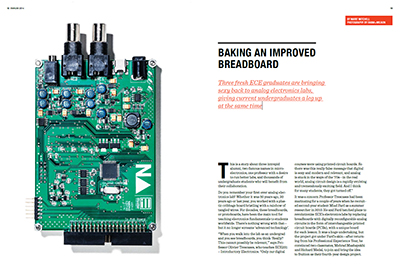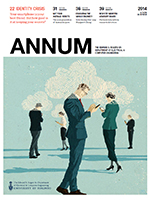Three fresh ECE graduates are bringing sexy back to analog electronics labs, giving current undergraduates a leg up at the same time
By Marit Mitchell

This is a story about three intrepid alumni, two famous names in microelectronics, one professor with a desire to run better labs, and thousands of undergraduate students who will benefit from their collaboration.
Do you remember your first-ever analog electronics lab? Whether it was 50 years ago, 20years ago or last year, you worked with a plastic cribbage board bristling with a rainbow of tangled wires. For decades, these breadboards, or protoboards, have been the main tool for teaching electronics fundamentals to students worldwide. There’s nothing wrong with that—but it no longer screams ‘advanced technology’.
“When you walk into the lab as an undergrad and you see breadboards, you think ‘Really? This cannot possibly be relevant,’” says Professor Olivier Trescases, who teaches ECE231– Introductory Electronics. “Only our digital courses were using printed circuit boards. So there was this really false message that digitalis sexy and modern and relevant, and analog is stuck in the ways of the ‘70s—in the real world, analog circuit design is a rapidly evolving and tremendously exciting field. And I think for many students, they got turned off.”
It was a concern Professor Trescases had been marinating for a couple of years when he recruited second-year student Miad Fard as a summer researcher in 2010. He and Fard hatched plans to revolutionize ECE’s electronics labs by replacing breadboards with digitally reconfigurable analog circuits in the form of interchangeable printed circuit boards (PCBs), with a unique board for each lesson. It was a huge undertaking, but the project got under Fard’s skin—after returning from his Professional Experience Year, he convinced two classmates, Mehrad Mashayekhi and Richard Medal, to join and bring the idea to fruition as their fourth-year design project.
“Protoboards are effective and versatile, but they’re not really being used in industry anymore. You could go all four years as an undergrad and not have the experience of using PCBs,” says Fard. “We wanted to introduce something that’s more industry-standard and help students become better engineers once they leave school.”
Their hardware-software system is straightforward and elegant: a central board, called NileDelta (or N Δ), connects to a computer running software with a graphical user interface that allows students to tinker easily. It updates the setup without compromising any of the tangible equipment that brings circuitry to life—students stimulate circuits with real sources, including music fed from their cellphones, a microphone, or function generators, and observe outputs using loads such as LEDs, headphones, motors or oscilloscopes. The team concurrently developed a set of auxiliary boards, called AELabs, which plug into N and let students configure and reconfigure circuits specially designed for each lesson with a different mix of transistors, resistors, capacitors and diodes. Every AELabs kit comes with a detailed lab manual with instructions and background material for each experiment, matched to its corresponding auxiliary board.
“This takes the manual component out of building and debugging circuits, which students still learn in a previous course,” says Medal. “They still have the hands-on experience, which is important, but now they can step up to modern technology and dive deeper into the concepts.” Adds Fard: “It also allows them more time for design-oriented tasks.”
Still undergrads themselves, Fard, Mashayekhi and Medal refined and printed the system over the course of their fourth year, and in spring 2013 tested it on a subset of 20 ECE231 students in the lab. Despite expected glitches, their product was well received, and earned the 2013 Gordon R. Slemon Design Award for exhibiting the best combination of imagination, design and execution of more than 100 projects.
But that was just the beginning. In the intervening 18 months, “the three graduated from the Electrical Engineering program and founded Illuster, their startup company, to commercialize the system. University of Toronto became their first customer, purchasing 45 kits to expand the project to all second-year students in ECE231. They spent much of spring 2014 helping students navigate the lab, taking in feedback about what was working and what wasn’t, and calibrating accordingly.
The Illuster system has drastically extended the scope of Professor Trescases’ syllabus. “Before we said, ‘Here’s the precise recipe, you bake the cake and if you have time left over, tell us how it tastes.’ Now we say, ‘This is the cake we want, this is how we want it to taste, you figure out the recipe and configure this thing. Now with this knowledge, show us how you can make it taste even better.’ There was not nearly enough time for that process in the past,” he says. “The labs are totally different now—we expanded our experiments, and we hope that students have learned a lot more.”
ECE Emeritus Professors Adel Sedra and K.C. Smith, authors of the ubiquitous textbook Microelectronic Circuits, have been instrumental in the project’s evolution since its early days—Professor Trescases, who himself worked on many of the simulations for the book’s accompanying CD as a student, brought the idea to Professor Smith right away, and later to Professor Sedra. Both are very enthusiastic about the platform and plan to mention it in their next edition. Microelectronic Circuits is an international bestseller and the endorsement could be a major break for Illuster—an opportunity to launch the next phase of their plan.
“What we’ve built is modular and expandable, and we intend to create additional kits with new auxiliary boards to teach other courses,” says Medal. “These could be used for digital electronics, power electronics, control systems, mechatronics. That’s our end goal—to reach out to schools and modernize and update the way that electronics is taught around the world.”
 This feature appeared in the latest issue of ANNUM: read or download the full magazine.
This feature appeared in the latest issue of ANNUM: read or download the full magazine.